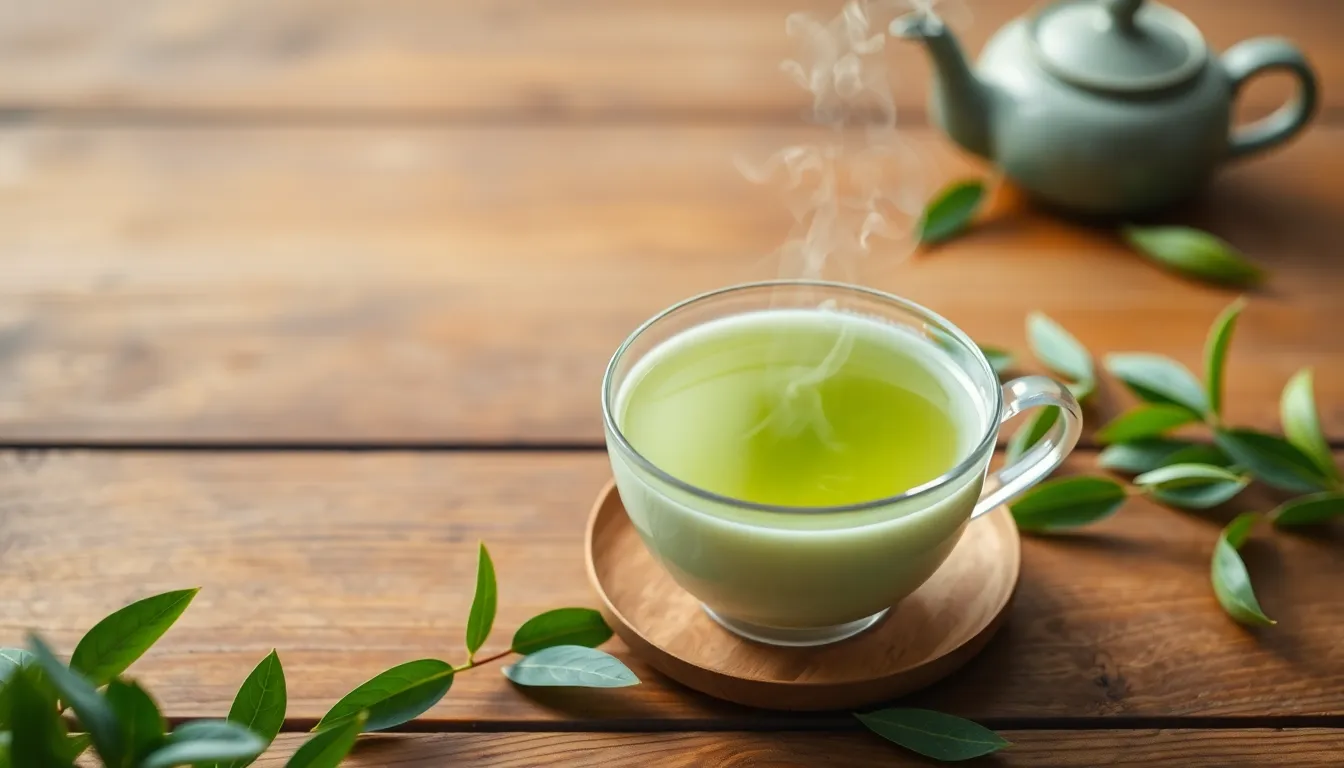When nausea strikes we’re all desperate for relief – and nature’s got our backs with powerful herbal teas that can settle even the most stubborn stomach. Whether you’re dealing with morning sickness, motion sickness, or just an upset tummy these time-tested remedies offer gentle yet effective answers that won’t leave you reaching for harsh medications.
We’ve discovered that certain teas don’t just taste amazing – they’re packed with compounds that specifically target nausea at its source. From the warming zing of ginger tea to the cooling comfort of peppermint these natural powerhouses have been soothing queasy stomachs for centuries.
The best part? You probably already have some of these miracle-working teas sitting in your kitchen cabinet right now. We’re about to share the most effective anti-nausea teas that’ll have you feeling better faster than you ever thought possible.
Ginger Tea: The Gold Standard for Nausea Relief
Ginger tea stands as our most trusted ally in the fight against nausea, backed by centuries of traditional use and modern scientific research. We’ve found that this powerhouse root contains gingerol and shogaol compounds that directly target the digestive system’s nausea triggers.
Fresh Ginger vs. Dried Ginger Benefits
Fresh ginger delivers more potent anti-nausea compounds than its dried counterpart, making it our top choice for immediate relief. We recommend using fresh ginger root because it contains higher concentrations of gingerol, the active compound responsible for reducing stomach upset and motion sickness.
Dried ginger offers convenience and longer shelf life while still providing effective nausea relief. Studies show that dried ginger contains concentrated shogaol compounds that form during the dehydration process, offering a different but equally valuable therapeutic profile.
Ground ginger powder provides consistent dosing and mixes easily into hot water, making it perfect for quick preparation. We’ve noticed that powdered ginger often produces a more uniform tea strength, which helps when you need predictable results for ongoing nausea management.
Optimal Brewing Time and Temperature
Water temperature between 195°F and 212°F extracts maximum beneficial compounds from ginger without destroying heat-sensitive elements. We’ve found that boiling water works perfectly for dried ginger, while slightly cooler water preserves more delicate compounds in fresh ginger root.
Steeping time of 10 to 15 minutes allows complete extraction of ginger’s therapeutic properties into your tea. Longer brewing times don’t necessarily increase effectiveness but may create an overly spicy taste that some people find difficult to drink when already feeling nauseous.
Covering your cup during steeping prevents essential oils from evaporating, ensuring you get the full anti-nausea benefits. We always recommend using a lid or small plate to trap the aromatic compounds that contribute to ginger’s stomach-settling properties.
Dosage Recommendations for Maximum Effectiveness
One to two teaspoons of fresh grated ginger per cup provides optimal nausea relief without overwhelming your digestive system. We’ve observed that this amount delivers approximately 250mg of active gingerol compounds, which clinical studies identify as the therapeutic threshold for nausea reduction.
Half a teaspoon of dried ginger powder per cup offers equivalent anti-nausea benefits with more concentrated potency. This smaller amount prevents the bitter aftertaste that can worsen nausea while still providing the 200-300mg of active compounds your body needs.
Three to four cups daily represents the maximum safe intake for most adults experiencing persistent nausea. We recommend spacing doses throughout the day rather than consuming large amounts at once, as this approach maintains steady therapeutic levels in your system.
| Ginger Type | Amount Per Cup | Active Compounds | Daily Limit |
|---|---|---|---|
| Fresh grated | 1-2 teaspoons | 250mg gingerol | 4 cups |
| Dried powder | 0.5 teaspoon | 200-300mg mixed | 4 cups |
| Tea bags | 1-2 bags | 150-200mg | 5 cups |
Peppermint Tea: Cooling Comfort for Upset Stomachs

While ginger tea leads the pack for nausea relief, peppermint tea offers a refreshing alternative that delivers cooling comfort when your stomach feels unsettled. We’ve found that this aromatic herbal tea provides a different but equally effective approach to managing digestive discomfort.
Menthol’s Natural Anti-Nausea Properties
Menthol serves as peppermint tea’s primary weapon against nausea, delivering both cooling sensations and direct anti-inflammatory effects on your digestive system. Research demonstrates that peppermint oil significantly reduces nausea and vomiting in patients undergoing chemotherapy, showcasing its powerful therapeutic potential. We’ve discovered that menthol’s cooling properties work by calming the stomach muscles and reducing the intensity of nausea signals sent to your brain.
Studies reveal that peppermint oil aromatherapy alone reduces nausea in hospitalized patients, indicating that even inhaling the tea’s steam can provide relief. The compound’s anti-inflammatory properties target the root causes of stomach irritation, making it particularly effective for nausea accompanied by digestive inflammation.
Best Times to Drink Peppermint Tea
Before meals represents the optimal timing for peppermint tea consumption, as it prepares your digestive system and prevents nausea from developing. We recommend sipping a warm cup 15-30 minutes before eating to maximize its protective effects on your stomach.
After meals offers another strategic window, particularly when you’re experiencing post-meal discomfort or bloating that leads to nausea. The tea’s soothing properties help calm your stomach and promote healthy digestion during this critical period.
During active nausea episodes, peppermint tea provides immediate relief when you need it most. We suggest keeping prepared tea readily available for these moments, as the cooling sensation can quickly ease symptoms and restore comfort.
Precautions for Those with GERD
GERD sufferers should exercise caution with peppermint tea, as it can worsen gastroesophageal reflux symptoms by relaxing the lower esophageal sphincter. This relaxation allows stomach acid to flow back into the esophagus more easily, potentially intensifying heartburn and acid reflux.
We strongly recommend consulting your healthcare provider before incorporating peppermint tea into your routine if you have diagnosed GERD. Alternative nausea remedies might better serve your needs without triggering reflux symptoms.
Individuals with mild occasional heartburn should monitor their response carefully, starting with small amounts to assess tolerance before regular consumption.
Chamomile Tea: Gentle Soothing for Sensitive Systems

Chamomile tea stands out as one of nature’s most gentle remedies for nausea relief. We’ve found that this flower-based tea works particularly well for those who can’t tolerate stronger herbal options or medications.
Anti-Inflammatory Compounds That Calm Digestion
Flavonoids, terpenoids, and volatile oils make chamomile tea exceptionally effective at reducing digestive inflammation. These bioactive compounds work together to relax the smooth muscles in our digestive tract, which directly addresses the cramping and discomfort that often accompany nausea.
Research demonstrates that chamomile’s anti-inflammatory actions help settle upset stomachs while reducing vomiting frequency. Antispasmodic effects from these natural compounds provide relief by preventing the muscle contractions that trigger nausea signals to our brain.
Terpenoids specifically target the digestive system’s inflammatory response, creating a calming effect that we can feel within minutes of drinking the tea. Volatile oils contribute additional soothing properties that work synergistically with the other compounds to provide comprehensive nausea relief.
Ideal for Pregnancy-Related Morning Sickness
Pregnant women often find chamomile tea more tolerable than other nausea remedies during their first trimester. Studies show that chamomile extract proved more effective than ginger at reducing nausea and vomiting in pregnant participants.
Morning sickness symptoms respond particularly well to chamomile’s gentle approach, as the tea doesn’t cause the stomach irritation that some stronger remedies might trigger. We recommend starting with small amounts to test tolerance, as individual responses can vary during pregnancy.
Healthcare providers should always be consulted before adding chamomile tea to a pregnancy wellness routine. Certain herbal teas carry potential risks during pregnancy, making professional guidance essential for safe use.
How to Choose Quality Chamomile
Organic chamomile flowers provide the purest option for nausea relief, free from pesticides and chemical contaminants that could worsen stomach sensitivity. We recommend selecting loose flowers over tea bags when possible, as they offer better control over potency and freshness.
| Chamomile Type | Amount | Water Temperature | Steeping Time |
|---|---|---|---|
| Loose flowers | 1 tablespoon (2g) | Hot (not boiling) | 5-10 minutes |
| Tea bags | 1 bag | Hot (not boiling) | 3-5 minutes |
Reputable brands that provide clear sourcing information ensure we’re getting therapeutic-grade chamomile. Look for suppliers who test their products for purity and potency, as quality directly impacts the tea’s effectiveness for nausea relief.
Freshness indicators include bright color, strong floral aroma, and intact flower heads when purchasing loose chamomile. Store your chamomile in airtight containers away from light and moisture to maintain its anti-nausea properties.
Fennel Tea: Traditional Digestive Aid with Modern Science

We’ve explored several effective teas for nausea relief, and fennel tea stands out as another powerful option that bridges ancient wisdom with contemporary research. This aromatic herbal remedy has been supporting digestive health for centuries while modern science validates its effectiveness.
Anethole’s Role in Reducing Nausea
Anethole serves as fennel’s primary active compound, delivering the tea’s distinctive licorice-like flavor and potent anti-nausea properties. This essential oil component works by relaxing gastrointestinal smooth muscle, which directly reduces stomach cramping and bloating that often accompany nausea episodes.
Research published in Fitoterapia demonstrates fennel’s effectiveness against motion sickness, making it particularly valuable for travel-related stomach upset. Studies show that anethole’s antispasmodic effects help prevent the muscle contractions that trigger nausea signals to our brain.
Individuals with irritable bowel syndrome experience important symptom improvement when consuming fennel tea regularly. The compound’s ability to calm digestive muscles makes it especially effective for nausea caused by indigestion or stomach irritation.
Preparation Methods for Maximum Potency
Crushing fennel seeds lightly before brewing releases maximum essential oils and enhances the tea’s therapeutic potential. We recommend using one teaspoon of lightly crushed seeds per cup of hot water for optimal strength.
Steeping time plays a crucial role in extracting beneficial compounds from fennel seeds. Allow the seeds to steep for 10 to 15 minutes in hot water to maximize anethole release while preserving the oil’s medicinal properties.
Fresh preparation delivers the most potent anti-nausea effects compared to pre-made teas or older seeds. Store fennel seeds in an airtight container away from light and heat to maintain their essential oil content for future brewing.
Safe Usage Guidelines
Most adults can safely consume fennel tea without experiencing adverse effects when following recommended dosages. But, excessive consumption may trigger allergic reactions in sensitive individuals or interact with certain medications.
| Consideration | Guideline |
|---|---|
| Maximum daily intake | 2-3 cups for most adults |
| Pregnancy safety | Consult healthcare provider before use |
| Medication interactions | Check with doctor if taking blood thinners |
| Allergic reactions | Discontinue if symptoms occur |
Pregnant individuals should discuss fennel tea consumption with their healthcare provider before incorporating it into their nausea management routine. While generally considered safe, professional guidance ensures the best outcomes during pregnancy.
Discontinue use immediately if you experience any adverse reactions such as skin irritation, breathing difficulties, or worsening digestive symptoms. These reactions, though rare, require medical attention and evaluation of your herbal tea choices.
Lemon Balm Tea: Citrusy Relief for Motion Sickness

We’ve found that lemon balm (Melissa officinalis) offers a gentler approach to nausea relief through its digestive soothing properties. Unlike the more potent herbs we’ve discussed, lemon balm works indirectly by calming gastrointestinal spasms and easing bloating that often accompanies motion sickness.
Rosmarinic Acid’s Anti-Nausea Effects
Rosmarinic acid serves as lemon balm’s primary active compound, providing antioxidant and anti-inflammatory benefits that support digestive health. Studies show this compound helps reduce inflammation in the gastrointestinal tract, which can contribute to nausea relief. Antispasmodic activities within rosmarinic acid calm stomach muscles and reduce cramping sensations that worsen motion sickness symptoms.
Research indicates that rosmarinic acid’s antioxidant properties may help protect the digestive system from stress-related damage during travel. While exact anti-nausea studies are limited, the compound’s ability to soothe mild tummy troubles like bloating and indigestion creates conditions that naturally reduce nausea intensity.
Combining with Other Herbs for Enhanced Benefits
Pairing lemon balm with ginger creates a powerful anti-nausea blend that combines gentle digestive soothing with proven nausea fighting compounds. We recommend mixing equal parts dried lemon balm and ginger root for a balanced tea that provides both immediate and sustained relief.
Chamomile and lemon balm work synergistically to address multiple aspects of motion sickness, with chamomile’s anti-inflammatory properties complementing lemon balm’s antispasmodic effects. This combination proves particularly effective for individuals who experience anxiety alongside their nausea symptoms.
Adding peppermint to lemon balm tea enhances the cooling effect while providing menthol’s direct anti-nausea benefits. Start with a 2:1 ratio of lemon balm to peppermint to maintain the gentle nature while adding digestive support.
Growing and Harvesting Your Own Lemon Balm
Cultivating lemon balm requires minimal effort as this hardy herb thrives in well-drained soil with partial to full sunlight exposure. Plant seeds or starter plants in spring after the last frost, spacing them 12-18 inches apart to allow for spreading growth.
Harvesting fresh lemon balm leaves provides maximum potency for your anti-nausea tea blends. Cut stems in the morning after dew has dried but before the heat of midday, selecting the youngest, most aromatic leaves for the best flavor and therapeutic compounds.
Drying your harvested lemon balm preserves its benefits for year-round use in motion sickness relief teas. Bundle small groups of stems and hang them in a well-ventilated, dark area for 1-2 weeks until leaves crumble easily between your fingers.
Green Tea: Light and Refreshing Nausea Management

Green tea offers a milder alternative to stronger herbal teas while still providing effective nausea relief. This gentle option works particularly well for those seeking sustained stomach comfort without overwhelming flavors.
L-Theanine’s Calming Properties
L-Theanine emerges as green tea’s secret weapon against nausea through its unique ability to promote relaxation throughout our digestive system. This amino acid creates a calming atmosphere for our stomach by reducing stress signals that often trigger or worsen nausea symptoms. Research shows that L-Theanine’s soothing effects help establish the mental tranquility needed for our body’s natural healing processes to work effectively.
Stress reduction becomes particularly important when dealing with nausea because anxiety and stomach upset often feed off each other in a troublesome cycle. L-Theanine breaks this pattern by promoting a sense of calm that allows our digestive system to function more smoothly. The compound works synergistically with green tea’s other beneficial substances to create a comprehensive approach to nausea management.
Lower Caffeine Content Advantages
Caffeine sensitivity plays a crucial role in choosing the right tea for nausea relief since high caffeine intake can sometimes worsen stomach discomfort. Green tea contains significantly less caffeine than black tea or coffee, making it a safer choice for those whose stomachs react poorly to stimulants. This lower caffeine profile means we can drink green tea throughout the day without risking increased nausea or jittery feelings.
Gentle stimulation rather than overwhelming energy characterizes green tea’s approach to supporting our system during nausea episodes. The moderate caffeine content provides just enough alertness to help us feel more balanced without creating the harsh effects that can upset sensitive stomachs. This makes green tea particularly valuable for morning nausea when we need something soothing yet energizing.
Best Varieties for Digestive Health
Gyokuro stands out among green tea varieties for its exceptional quality and high concentration of beneficial compounds that support digestive wellness. This premium Japanese tea offers superior catechin content while maintaining the gentle character that makes green tea suitable for upset stomachs. The careful cultivation process results in a tea that delivers maximum health benefits with minimal risk of stomach irritation.
Longjing provides another excellent option for those seeking digestive support through green tea’s natural properties. This Chinese variety combines smooth flavor with substantial health benefits, making it particularly appealing for regular consumption during periods of digestive sensitivity. Both Gyokuro and Longjing offer the advantage of being less likely to cause stomach upset compared to lower quality green teas.
Temperature and timing matter significantly when using green tea for nausea management since consuming it on an empty stomach or at improper temperatures can actually worsen symptoms. We recommend brewing green tea at appropriate temperatures and drinking it after meals to minimize potential side effects from tannins and other compounds. Individual tolerance varies, so starting with small amounts helps determine the best approach for each person’s digestive system.
Dandelion Root Tea: Bitter Herbs for Digestive Balance

Dandelion root tea stands out as one of nature’s most potent bitter herbs for addressing nausea through comprehensive digestive support. This traditional remedy contains powerful biologically active compounds including taraxasterol, caffeic acid, chicoric acid, polysaccharides, and inulin that work together to improve stomach contractions and ease various gastrointestinal disorders.
Liver Support and Nausea Connection
Liver health plays a crucial role in managing nausea symptoms, and dandelion root tea offers important hepatoprotective benefits that can provide relief. The liver’s detoxification processes and bile production are essential for proper digestion, and when liver function becomes compromised, nausea often follows.
Dandelion root’s hepatoprotective effects work by reducing inflammation throughout the liver while promoting healthy bile flow. Enhanced bile production improves fat digestion and prevents the digestive sluggishness that commonly triggers nausea episodes. Research shows that dandelion’s anti-inflammatory compounds help restore optimal liver function, which directly impacts our body’s ability to process toxins that might otherwise contribute to stomach upset.
We’ve found that supporting liver health through dandelion root tea creates a domino effect of digestive improvements. Better liver function means more efficient toxin elimination, improved nutrient absorption, and eventually less strain on the digestive system that can manifest as nausea.
Detoxification Benefits
Detoxification through dandelion root tea offers multiple pathways for nausea relief by addressing the root causes of digestive discomfort. The tea’s natural diuretic properties increase urine production, facilitating the elimination of toxins that can accumulate and cause stomach upset.
Dandelion root’s antioxidative compounds work to reduce oxidative stress throughout the digestive system. These powerful antioxidants neutralize free radicals that can damage digestive tissues and contribute to inflammation-related nausea. The anti-inflammatory effects help calm irritated stomach lining and reduce the inflammatory responses that often trigger nausea signals.
Toxin buildup in our system frequently manifests as digestive discomfort and nausea symptoms. Dandelion root tea supports our body’s natural detox pathways by improving kidney function and promoting lymphatic drainage. This comprehensive approach to detoxification helps maintain digestive comfort and reduces the likelihood of toxin-related nausea episodes.
Taste Enhancement Tips
Dandelion root tea’s naturally bitter flavor can be challenging for many people, but several simple modifications can improve palatability while maintaining its therapeutic benefits. Adding natural honey provides sweetness that balances the bitter compounds without interfering with the tea’s digestive properties.
Combining dandelion root tea with complementary herbs creates more pleasant flavor profiles while improving anti-nausea effects. Fresh ginger adds warming spice and additional stomach-soothing properties, while lemon provides bright citrus notes that help mask bitterness. Peppermint leaves contribute cooling refreshment along with their own digestive benefits.
Brewing techniques significantly impact the final taste intensity of dandelion root tea. Shorter steeping times of 3-5 minutes produce milder flavors, while longer brewing extracts more bitter compounds along with therapeutic substances. We recommend starting with shorter steeping periods and gradually increasing as your palate adapts to the natural bitterness.
Temperature control also affects taste development during preparation. Using water that’s slightly cooler than boiling (around 185°F) reduces the extraction of harsh tannins while preserving beneficial compounds. This gentler brewing approach creates a smoother, more approachable flavor profile that’s easier to enjoy regularly.
Red Raspberry Leaf Tea: Pregnancy-Safe Nausea Support

Red raspberry leaf tea offers expecting mothers a gentle herbal option for managing nausea, though scientific evidence supporting its effectiveness remains limited. Many midwives and herbalists recommend this traditional remedy for morning sickness relief during pregnancy.
Safe Consumption During Different Trimesters
First trimester consumption requires careful consideration due to the tea’s potential uterine stimulating properties. Healthcare providers often advise avoiding red raspberry leaf tea during early pregnancy because of anecdotal concerns about miscarriage risk, though scientific evidence connecting the two remains largely unestablished.
Second and third trimesters represent the optimal time for introducing red raspberry leaf tea into your pregnancy routine. We recommend starting consumption during the second trimester when most practitioners agree it’s safe to begin strengthening uterine muscles in preparation for labor.
Third trimester benefits become most pronounced as your body prepares for delivery. Regular consumption during these final months may help tone the uterine muscle and potentially reduce the need for labor interventions.
Nutritional Benefits Beyond Nausea Relief
Essential minerals make red raspberry leaf tea particularly valuable during pregnancy beyond its nausea fighting properties. Iron content supports increased blood volume requirements, while calcium contributes to both maternal bone health and fetal development.
Magnesium levels in the tea help prevent muscle cramps and support proper nerve function throughout pregnancy. These vital nutrients work together to address common pregnancy deficiencies that can contribute to overall discomfort and fatigue.
Uterine muscle toning represents one of the most well known benefits of regular red raspberry leaf tea consumption. Traditional herbalists believe this strengthening effect may lead to more efficient contractions during labor and potentially shorter delivery times.
Brewing Strength Recommendations
Package instructions provide the safest starting point for brewing red raspberry leaf tea during pregnancy. We suggest beginning with a mild infusion to assess your body’s tolerance before gradually increasing strength if needed.
Standard brewing involves steeping one teaspoon of dried leaves in eight ounces of hot water for 10 to 15 minutes. This moderate strength allows you to monitor how your body responds while still receiving the tea’s beneficial compounds.
Healthcare provider consultation becomes essential before adding any herbal remedies to your pregnancy routine. Your doctor can provide personalized guidance based on your exact health history and pregnancy progression to ensure both safety and effectiveness.
Licorice Root Tea: Sweet Solution for Stomach Distress

Licorice root tea offers a naturally sweet approach to calming upset stomachs and reducing nausea. This traditional remedy has been used for centuries to address various digestive issues through its unique anti-inflammatory properties.
Glycyrrhizin’s Anti-Inflammatory Effects
Glycyrrhizin serves as the primary active compound in licorice root that delivers potent anti-inflammatory benefits. This natural substance works by reducing inflammation throughout the digestive system, which can help alleviate the underlying causes of nausea and stomach discomfort.
Research indicates that glycyrrhizin’s anti-inflammatory effects may support digestive health, though more comprehensive studies are needed to fully understand its exact impact on nausea relief. The compound targets inflammatory pathways that often contribute to digestive distress and stomach upset.
We find that licorice root tea’s anti-inflammatory properties make it particularly effective for individuals experiencing chronic digestive issues. These effects work synergistically with the body’s natural healing processes to restore stomach comfort.
Safety Considerations and Daily Limits
Safety becomes paramount when incorporating licorice root tea into your nausea management routine. Excessive consumption can lead to hypertension and dangerously low potassium levels, which may require immediate medical attention.
We recommend limiting licorice root tea consumption to one cup per day to avoid potential adverse effects. This moderate intake allows you to experience the digestive benefits while minimizing health risks.
Individuals with existing heart conditions, kidney problems, or high blood pressure should consult their healthcare provider before adding licorice root tea to their wellness routine. Pregnant women should exercise particular caution and seek professional guidance before use.
Combining with Other Digestive Herbs
Licorice root tea blends exceptionally well with other digestive herbs to enhance its nausea-fighting properties. Combining it with ginger creates a powerful duo that addresses multiple aspects of stomach discomfort.
Peppermint pairs beautifully with licorice root, creating a soothing blend that combines cooling menthol with anti-inflammatory glycyrrhizin. This combination provides both immediate relief and longer-term digestive support.
We suggest experimenting with small amounts of chamomile or fennel when blending with licorice root tea. These gentle herbs complement licorice’s sweet flavor while adding their own digestive benefits to create a comprehensive nausea remedy.
Cardamom Tea: Aromatic Spice for Quick Nausea Relief

Cardamom tea stands out as a powerful member of the ginger family, offering natural relief for nausea through its potent digestive properties. This aromatic spice has been traditionally used to combat nausea, vomiting, and digestive discomfort, making it particularly effective for motion sickness and morning sickness.
Essential Oils That Combat Nausea
Cardamom’s effectiveness stems from its rich essential oil content, which contains compounds that directly target nausea symptoms. These oils work by relaxing stomach muscles and reducing inflammatory responses that contribute to digestive distress. Combining cardamom tea with complementary essential oils like peppermint, ginger, and lemon can enhance its anti-nausea effects. Many people find that inhaling cardamom’s natural aroma while sipping the tea provides additional relief through aromatherapy benefits.
Traditional Ayurvedic Applications
Ayurvedic medicine has utilized cardamom for centuries as a primary digestive aid and nausea remedy. Practitioners often combine crushed cardamom seeds with other warming spices to create comprehensive treatments for various stomach ailments. This ancient system recognizes cardamom as a natural carminative that helps relieve gas and streamline digestion. Traditional preparations frequently include cardamom in digestive blends designed to prevent stomach contractions and calm irritated digestive tissues.
Simple Preparation Methods
Creating effective cardamom tea requires proper technique to extract maximum therapeutic benefits from the seeds. We recommend crushing 1-2 teaspoons of fresh cardamom pods before adding them to boiling water for optimal compound release. Steeping the crushed pods for 5-7 minutes allows sufficient time for the active compounds to infuse into the water. Straining the tea before drinking ensures a smooth texture while preserving the beneficial properties. Pregnant individuals should consult their healthcare provider before incorporating cardamom tea into their nausea management routine to ensure safety for both mother and baby.
Conclusion
Natural remedies like herbal teas offer us effective and gentle answers for managing nausea without relying solely on medications. Each tea we’ve explored brings unique benefits – from ginger’s powerful gingerol compounds to peppermint’s cooling menthol and chamomile’s soothing anti-inflammatory properties.
We can find relief by experimenting with different options to discover what works best for our individual needs. Whether we’re dealing with morning sickness pregnancy nausea motion sickness or general stomach upset these time-tested remedies provide accessible alternatives that many of us already have in our pantries.
Remember to start with small amounts to test your tolerance and always consult healthcare providers when pregnant or managing chronic conditions. With the right herbal tea in our wellness toolkit we’re better equipped to handle nausea naturally and effectively.
Frequently Asked Questions
What is the most effective tea for nausea relief?
Ginger tea is considered the gold standard for nausea relief, supported by both traditional use and modern research. Fresh ginger contains higher concentrations of gingerol, the active compound that alleviates nausea, making it more potent than dried ginger. Use 1-2 teaspoons of fresh grated ginger per cup for optimal effectiveness.
How does peppermint tea help with nausea?
Peppermint tea contains menthol, which has natural anti-nausea properties that calm stomach muscles and reduce nausea signals to the brain. Research shows peppermint oil can significantly reduce nausea and vomiting, particularly in chemotherapy patients. However, people with GERD should consult their healthcare provider before use.
Is chamomile tea safe for pregnant women with morning sickness?
Chamomile tea is a gentle remedy suitable for pregnant women experiencing morning sickness, as its anti-inflammatory compounds help reduce digestive inflammation and relax stomach muscles. However, pregnant women should start with small amounts and consult their healthcare provider before adding chamomile to their wellness routine.
How much ginger tea can I safely drink daily?
Adults can safely consume three to four cups of ginger tea daily for persistent nausea. Use 1-2 teaspoons of fresh grated ginger or half a teaspoon of dried ginger powder per cup. This dosage provides effective relief while staying within safe consumption limits.
Can fennel tea help with motion sickness?
Yes, fennel tea is effective against motion sickness due to anethole, its primary active compound that relaxes gastrointestinal smooth muscle and reduces stomach cramping. Research supports its effectiveness for motion sickness and benefits for individuals with irritable bowel syndrome. Limit intake to 2-3 cups daily.
When should I drink peppermint tea for nausea?
Drink peppermint tea before meals to prevent nausea, after meals to alleviate post-meal discomfort, or during active nausea episodes for immediate relief. The cooling menthol provides quick comfort for upset stomachs and helps reduce nausea symptoms effectively.
Is red raspberry leaf tea safe during pregnancy?
Red raspberry leaf tea is generally considered pregnancy-safe but should be introduced during the second and third trimesters. While scientific evidence for nausea relief is limited, it provides iron, calcium, and magnesium. Always consult your healthcare provider before adding it to your pregnancy routine.
How do I prepare cardamom tea for nausea?
Crush 3-4 cardamom pods and steep in hot water for 5-10 minutes to release essential oils that relax stomach muscles and reduce inflammation. Cardamom tea is particularly effective for motion sickness and morning sickness, especially when combined with other digestive herbs like ginger.
























